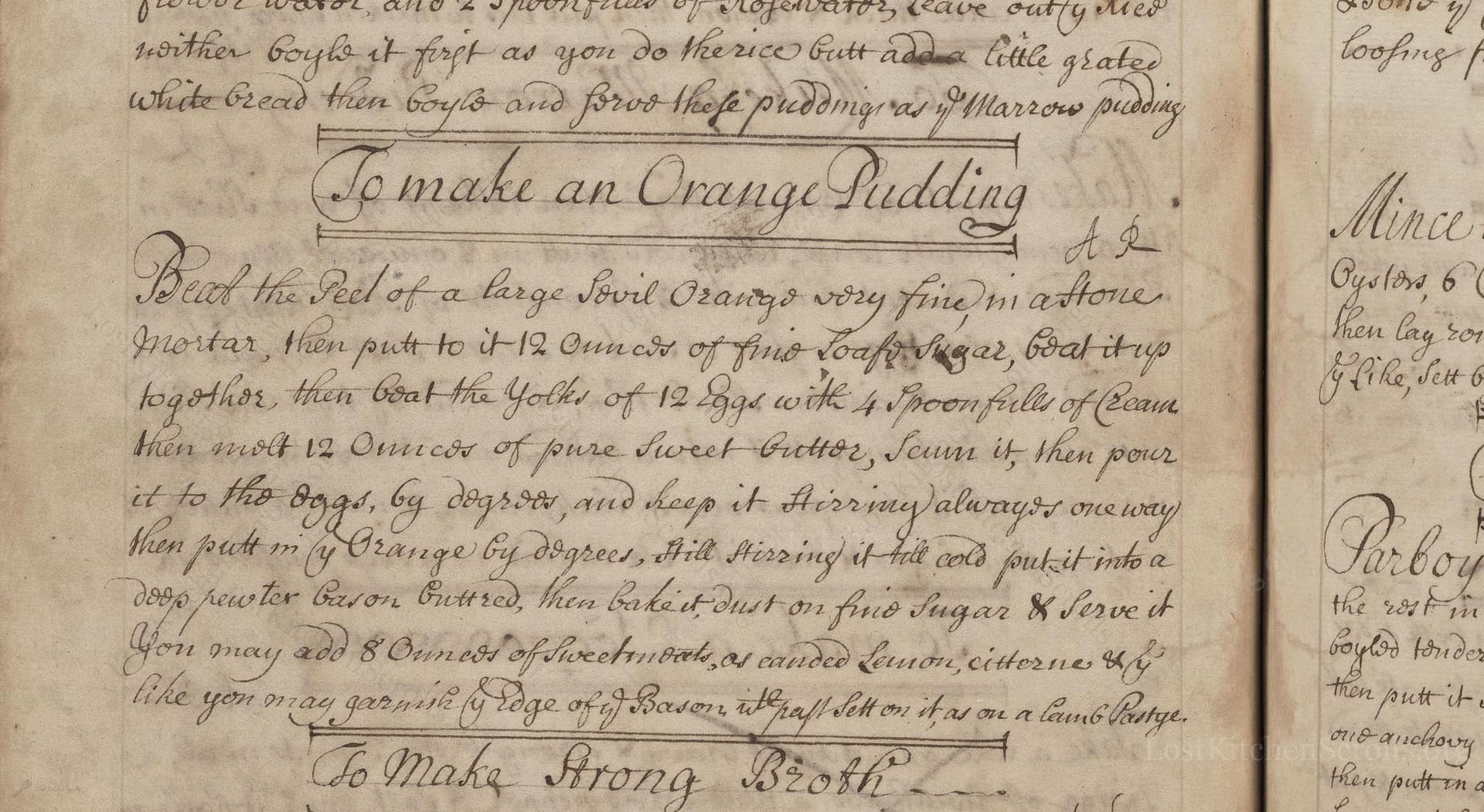To Make An Orange Pudding
From the treasured pages of English cookery and medicine book,
Unknown Author

To Make An Orange Pudding
"Beat the Peil of a large Sevill Orange very fine in a stone Mortar, then putt to it 12 Ounces of fine Loafe Sugar, beat it up together, then beat the Yolks of 12 Eggs with 4 Spoonfulls of Cream then melt 12 Ounces of pure Sweet Butter, Scum it, then pour it to the Eggs, by degrees, and keep it Stirring always one way then putt in ye Orange by degrees, till Stirring it till cold putt it into a deep pewter Bason Butter.ed, then bake it dust on fine Sugar & Serve it You may add 8 Ounces of Sweet almonds, as canded Lemon, citterne & if like you may garnish ye Edge of ye Bason wth puff past sett on it as on a lamb Pastye."
Note on the Original Text
Spelling in the recipe is idiosyncratic and phonetically influenced—the word 'Peil' refers to 'peel'; 'Loafe Sugar' means refined white sugar formed into loaves; 'Scum' means to remove the foam from melted butter. Directions often blend process and ingredients as narrative, offering room for improvisation or adaptation. Quantities are precise (by weight), but temperatures are unstated; a cook was expected to know the right oven heat by experience. The lack of punctuation and the single-paragraph style was typical for the period, making recipes a kind of oral tradition set to paper.

Title
English cookery and medicine book, (1694)
You can also click the book image above to peruse the original tome
Writer
Unknown
Era
1694
Publisher
Unknown
Background
A delightful journey through late 17th to early 18th-century kitchens, this tome features recipes, culinary wisdom, and mouthwatering secrets from an era where feasts reigned supreme and the art of cooking was celebrated with flourish.
Kindly made available by
Folger Shakespeare Library
This sumptuous orange pudding is drawn from an English manuscript recipe collection dating between 1677 and 1711, a period when exotic fruits like Seville oranges were a prized kitchen luxury in Britain. Recipes such as this one were often shared among the wealthy, with an emphasis on rich ingredients like eggs, sugar, and butter—ingredients that spoke of status and opulence. The inclusion of almonds and candied citrus shows the influence of continental European confectionery and the growing access to imported goods during the age of exploration and trade.

The original recipe would have called for a stone mortar and pestle to grind the orange peel and sugar, ensuring a fragrant paste. Eggs and cream were likely beaten with simple wooden spoons or whisks. The melted butter might have been prepared over an open hearth, and fine pewter or ceramic basins were used as baking vessels. Recipes often suggested baking in a brick oven or over the gentle embers of a kitchen fire, with careful monitoring.
Prep Time
20 mins
Cook Time
35 mins
Servings
10
We've done our best to adapt this historical recipe for modern kitchens, but some details may still need refinement. We warmly welcome feedback from fellow cooks and culinary historians — your insights support the entire community!
Ingredients
- Zest of 1 large Seville orange (or other bitter orange if unavailable)
- 12 oz caster sugar
- 12 large egg yolks
- 1/4 cup double cream
- 12 oz unsalted butter
- Optional: 8 oz ground sweet almonds
- Optional: 2 1/2 oz candied lemon peel or citron
- Optional: Puff pastry for edging
- Butter for greasing
- Extra sugar for dusting
Instructions
- Begin by finely grating the peel (zest) of a large Seville orange, taking care to avoid the bitter white pith.
- In a bowl or food processor, mix the orange zest with 12 ounces of caster sugar, grinding until the sugar is infused with the citrus oils.
- In a seperate bowl, whisk together the yolks of 12 large eggs with 4 tablespoons (about 1/4 cup) of double cream.
- Gently melt 12 ounces of unsalted butter, skimming off any foam, and gradually whisk into the eggs and cream, ensuring the mixture stays smooth and does not scramble.
- Slowly add the orange-sugar mixture to the eggs and butter, stirring continuously in one direction.
- Allow to cool slightly, then pour into a generously buttered deep ovenproof dish (a modern pudding basin would work nicely).
- Bake in a moderate oven (about 340°F/170°C) until set and just wobbling in the center, 30-40 minutes.
- Dust with fine sugar before serving.
- For variation, add 8 ounces of ground sweet almonds, a handful of candied lemon or citron peel.
- Optionally, line the edge of the dish with strips of puff pastry before baking for a decorative finish.
Estimated Calories
480 per serving
Cooking Estimates
Preparing the ingredients will take around 20 minutes, including zesting the orange, infusing the sugar, whisking eggs, and melting butter. Baking the pudding takes 35 minutes on average. Each serving contains about 480 calories, and the whole recipe serves 10 people.
As noted above, we have made our best effort to translate and adapt this historical recipe for modern kitchens, taking into account ingredients nowadays, cooking techniques, measurements, and so on. However, historical recipes often contain assumptions that require interpretation.
We'd love for anyone to help improve these adaptations. Community contributions are highly welcome. If you have suggestions, corrections, or cooking tips based on your experience with this recipe, please share them below.
Join the Discussion
Rate This Recipe

Den Bockfisch In Einer Fleisch Suppen Zu Kochen
This recipe hails from a German manuscript cookbook compiled in 1696, a time whe...

Die Grieß Nudlen Zumachen
This recipe comes from a rather mysterious manuscript cookbook, penned anonymous...

Ein Boudain
This recipe comes from an anonymous German-language manuscript cookbook from 169...

Ein Gesaltzen Citroni
This recipe, dating from 1696, comes from an extensive anonymous German cookbook...
Browse our complete collection of time-honored recipes



